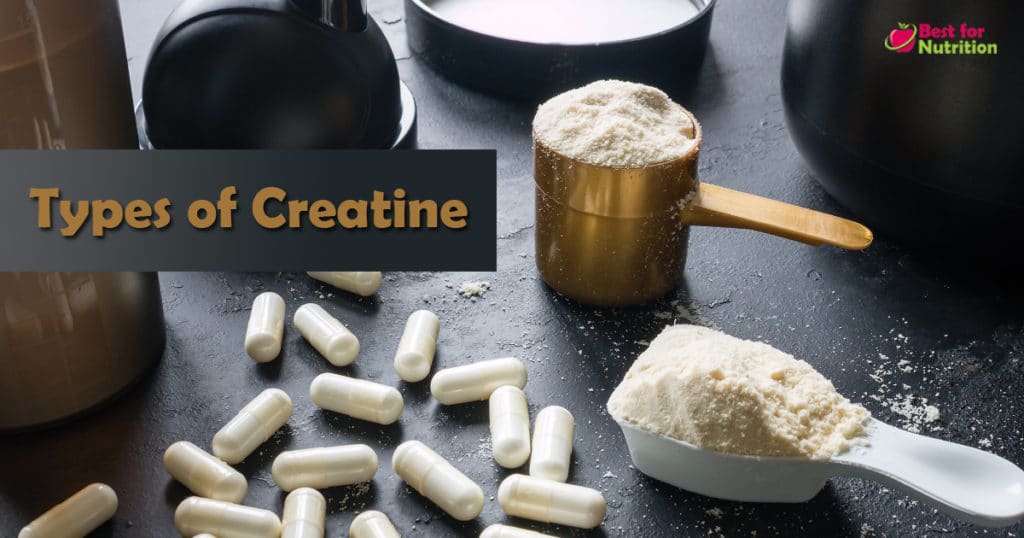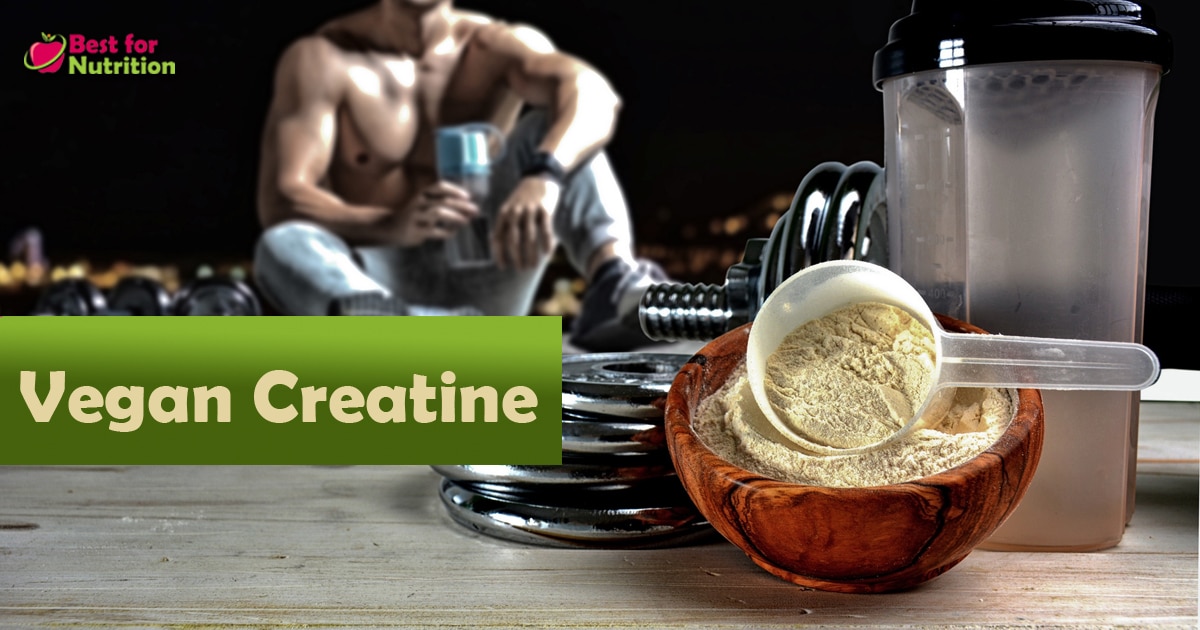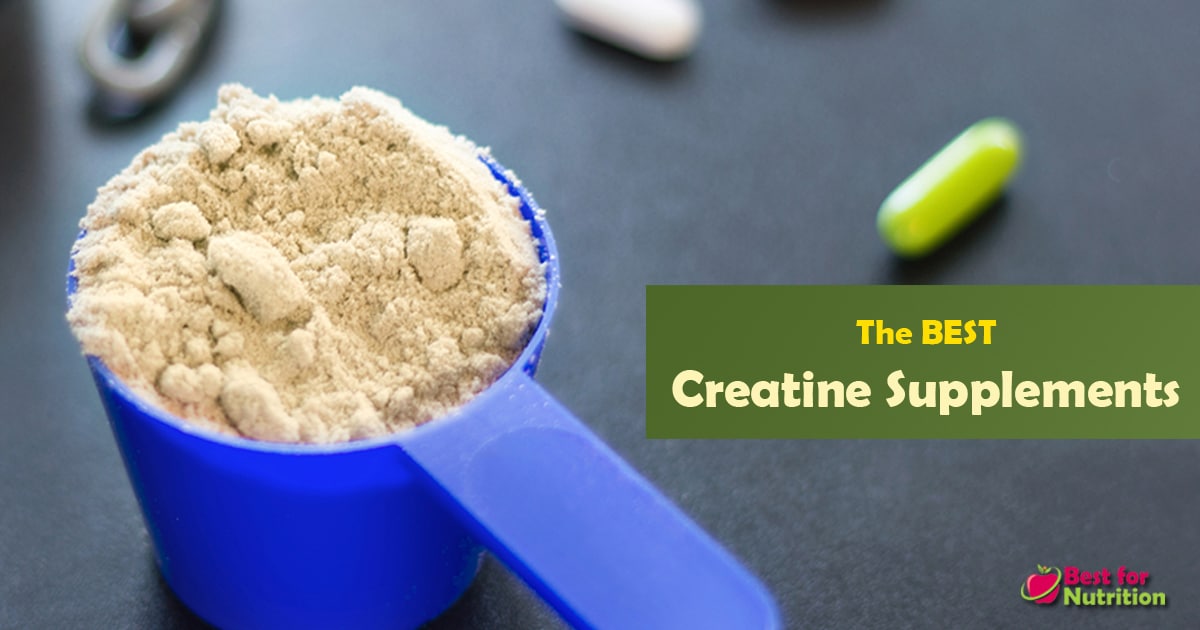One of the most widely researched supplements in the world is creatine.
It is naturally produced by the body. However, consuming supplements increases the body’s creatine stores.
Creatine serves a variety of important functions in the body. This helps significantly improve your workout performance, and endurance, and provide the spurt of energy that is needed for intense physical activity.
However, different types of creatine supplements have flooded the market and each has its own unique claims.
From the ever-popular creatine monohydrate to creatine HCL, liquid creatine, and even kre-alkalyn, there are so many forms of creatine available in the stores.
Let’s take a closer look at the various kinds of creatine to see how effective they are and which type of creatine is best for your needs.

What is Creatine?
Creatine is an organic molecule that is created by three amino acids, glycine, arginine, and methionine (1). It is produced mainly in the liver. It is also produced in the kidneys and pancreas to a lesser extent (2).
These three amino acids are non-essential amino acids that are produced naturally by the body (3). Meat and fish are the primary food source of creatine (4).
Several factors may affect the creatine store in your body. This includes your meat intake, exercise, amount of muscle mass, and levels of anabolic hormones (muscle forming muscle hormones), such as testosterone and IGF-1. Supplementing with creatine has shown a 40% increase in muscle creatine content (5).
It quickly produces energy while exercising which helps you train better. It also boosts muscle mass growth and strength.
Summary: Creatine is naturally produced in the body from three amino acids, arginine, methionine, and glycine. Creatine is mostly found in muscles and is the primary provider of energy.
How Does Creatine Work?
Creatine is converted into phosphocreatine and is stored in your muscles where it is used for energy as per requirement (6). 95% of the creatine in your body is stored in the muscles in this form. Remaining 5% are found in your brain, liver, and kidneys (7).
Creatine helps in the formation of adenosine triphosphate (ATP), which is the body’s energy currency. The more is the ATP in the body, the better your body can perform (8).
Supplementing your body with creatine and with regular training, you may promote increased muscle mass and muscle growth. In addition to that, creatine boosts your endurance, increases performance and strength, reduces the breakdown of muscles, and aids in muscle recovery post-workout (9).
When tested in anaerobic sports activity, creatine supplementation has shown improved performance. Creatine can also improve working memory, especially in vegetarians or old people who have lower creatine levels (10).
Creatine supplements are financially acceptable, highly effective starting from beginners at the gym to the top athletes in the world.
However, the various kinds of products that have flooded the market, can be very confusing. Therefore, we have explained all the different types of creatine to give you a clear understanding of its efficiencies.
Summary: Creatine forms phosphocreatine in your body, which helps your body produce high energy molecules called ATP that help you perform better while exercising.
The 10 Different Forms of Creatine
Creatine comes in multiple forms when we are looking into the world of supplements. Let’s have a look at the most common forms of creatine that you may encounter while buying nutritional supplements.
Creatine Monohydrate
The most common creatine supplement in the market is creatine monohydrate. It is the form that has been used in all the studies which have shown creatine as a top supplement. In other words, the most scientific effects of creatine have been observed while consuming this form (11).
Creatine monohydrate is made of creatine and water molecules. If the water is removed, it becomes anhydrous creatine. This removal increases the amount of creatine in the dose (12).
Therefore, the classical creatine monohydrate has 90% pure creatine whereas anhydrous creatine has 100%.
The other form of creatine monohydrate that is available is micronized creatine or mechanically processed creatine. This has better water solubility which leads to faster absorption of creatine in the body.
This is theoretically possible but it is not sufficiently confirmed yet.
Although creatine monohydrate is present in several forms due to different processing, they are similarly effective at the same dose. Creatine monohydrate in addition to increasing strength can also increase the water content in the muscles making it bigger and fuller.
5-10 g of creatine monohydrate can increase performance, muscle endurance, and muscle size (13).
It is safe, highly effective, and affordable. Even though minor side effects have been recorded in some, creatine monohydrate is still voted to be the best amongst all.
Summary: Creatine monohydrate is safe and highly effective. Despite the minor side effects amongst some, it is the widely studied and most common form of creatine supplement.
Creatine Hydrochloride
Creatine hydrochloride (HCl) is highly preferred for its effective water solubility. It is made by binding creatine to the hydrochloride molecule and has gained considerable popularity amongst supplement users (14).
In a 2010 study, it was confirmed that creatine hydrochloride is 38 times more soluble than the creatine monohydrate (15).
It is speculated that this super-solubility can mean a lower dose can be used.
Hence, nutritional supplement with this type of creatine has less than 1 g of active ingredient per dose. This is pretty low as compared to creatine monohydrate, with its 5 g dosage.
Creatine HCl is far more suitable for people who suffer from creatine monohydrate stomach problems (16).
Unfortunately, there aren’t any published experiments on creatine hydrochloride in humans.
Not many studies have been done to date where the two have been directly compared in experiments, hence the HCl form can’t be stated as superior.
Summary: Creatine hydrochloride is highly soluble in water as compared to creatine monohydrate and is speculated to be effective with a much lower dosage than needed for the monohydrate form.
Creatine Ethyl Ester
It has been claimed by some manufacturers that creatine ethyl ester is better than other creatine supplements including creatine monohydrate.
Some studies have confirmed this theory. It is also believed that creatine ethyl ester is better than the monohydrate, in terms of the muscle uptake rate of creatine (17).
However, a 2009 study directly compared the two and found that this wasn’t correct. In fact, creatine ethyl ester was worse at increasing creatine content in the blood and muscles than creatine monohydrate (18).
For this reason, this form is not much recommended and further studies await.
Summary: According to some manufacturers, creatine ethyl ester is absorbed the best in the body compared to any other creatine supplements. However, a study stated the opposite.
Creatine Ethyl Ester Malate
Creatine Ethyl Ester Malate is a rapidly absorbed form of creatine ethyl ester. This is because of the addition of malate. When compared to Creatine Ethyl Ester, the malate form has superior absorption and quicker utilization.
Summary: When malate is added to the creatine ethyl ester, it is converted into creatine ethyl ester malate which has a very high absorption rate. More studies are needed in this regard.
Creatine Gluconate
Creatine gluconate is claimed to be the new best creatine formula in the fitness industry.
Creatine gluconate is creatine bonded with glucose. It is particularly designed to enhance the uptake of creatine to the muscles. It focuses on ensuring that the creatine reaches the muscle cells, the exact place where it is needed the most.
The glucose that is bound to the creatine, is a fast-acting carbohydrate that helps in the quicker transport of creatine in these cells.
This ensures better strength, endurance, and size gain than others.
However, it may result in an insulin spike which is not very desirable before training as it decreases fat breaking phase.
Summary: Creatine gluconate is formed by bonding creatine with glucose. This ensures speedy uptake of creatine into the muscles, where they are used.
Buffered Creatine Monohydrate (Kre-alkalyn)
Buffered creatine monohydrate or Kre-alkalyn is the corrected pH form of creatine monohydrate. It is done by adding an alkaline powder to the micronized creatine monohydrate.
This helps increase its stability in the stomach’s environment, which improves its absorption into the muscles. It is also believed to reduce side effects such as bloating and cramping.
Evaluation of the effectiveness of this form of creatine has been done only in one 2012 study. Here, 36 resistance-trained participants were randomly assigned to three groups and were given the same doses of creatine monohydrate and kre-alkalyn for 28 days. The third group was given a lower dose of kre alkalyn for a similar period (19).
The study concluded that a lower dose of Kre-alkalyn was sufficient and there was no need for the saturation phase, unlike creatine monohydrate.
Despite all the above benefits, Kre-alkalyn is very expensive as compared to creatine monohydrate and other products.
Summary: The buffered creatine or Kre-alkalyn is the pH corrected form of creatine monohydrate that is better absorbed and is believed to reduce the side effects related to the later. Do remember it is highly effective but quite costly.
Liquid Creatine
Liquid creatine is the liquid form of creatine which is different from the popular traditional powder form. Therefore, instead of going through the pain of mixing your supplement with water or a sports drink, you can take it around with you. It comes as a bottle of liquid.
There hasn’t been much research related to the liquid creatine to confirm its effectiveness over the monohydrate form (20).
A 2004 study, found that creatine powder improved the work performed during cycling by 10% as compared to the liquid form (21).
In fact, it was observed that creatine when remains in liquid for several days, may break down. This doesn’t happen immediately, therefore mixing your creatine supplement powder with water right before consumption shouldn’t give you any problem (22).
Most research has used powdered supplements in this manner, and so it is the recommended way to consume.
Summary: Liquid creatine is convenient for intake but is known to break down and be ineffective if remained in liquid form for some time. Studies haven’t confirmed any improvement in exercise performance by taking liquid creatine.
Creatine Magnesium Chelate
Another form of creatine is creatine magnesium chelate, which is produced from binding magnesium to the creatine molecule. It is relatively new in the health market and is believed to have several muscle-related benefits.
A 2004 study, compared bench pressure, and performance of athletes amongst three groups. The first group took creatine monohydrate, the second group received creatine magnesium chelate and the third group was given a placebo (23).
Both the creatine groups were better in performance than the placebo. It concluded that even though creatine magnesium chelate is as effective as creatine monohydrate, it is not superior to it.
More research and studies are needed to understand the efficiency of creatine magnesium chelate in comparison to creatine monohydrate.
Summary: Some studies have shown that creatine magnesium chelate is as effective as creatine monohydrate. However, lack of adequate information prevents us from recommending them.
Creatine Citrate
This form of creatine is produced by combining creatine with organic citric acid. This acid is naturally found in citrus fruits and is often used as a natural flavor in supplements.
Theoretically, creatine citrate is more soluble in water than creatine monohydrate, but studies haven’t found any significant differences.
A 2007 study by the International Society of Sports Nutrition, when compared the two supplements directly, found no difference in their absorption rate (24).
Summary: The addition of citric acid to creatine is believed to increase solubility in water resulting in better absorption of creatine. But, studies are yet to prove the same.
Creatine Nitrate
One of the newest forms of creatine supplement is creatine nitrate. It is claimed by the manufacturer that the binding of the creatine molecule increases the efficiency of the product.
This will mean a lower dose than creatine monohydrate. A study in 2016, noted the effect of creatine nitrate on improving performance. However, no notable difference was observed (25).
But, preliminary findings did suggest that creatine nitrate can be as effective as creatine monohydrate in improving performance, provided you take it at least for 28 days.
Summary: Creatine nitrate is creatine bound to a nitrate group which improves the efficiency of the product. Though preliminary studies suggest its effectiveness after a certain duration of consumption, more is needed in this regard.
Frequently Asked Questions (FAQs)
Which is the Best Type of Creatine?
Now let’s get to the most important query: Of these 10 different types of creatine, which form of creatine is most effective?
Based on scientific evidence, the most recommended form of creatine is creatine monohydrate. Research has demonstrated its effectiveness in increasing the body’s stores.
Creatine monohydrates have also shown most effective in improving exercise performance and combating diseases.
Because it is safe, well researched, highly effective, and affordable, creatine monohydrate has long been considered the best amongst all creatine supplements.
Which is Better: Creatine Pills, Powders, or Liquids?
With the understanding of the wide variety of creatine supplements available in the market, the next big question that arises is which is better amongst pills, powder, or liquid.
Let’s have a look at them one by one.
Creatine powders: Powder form of creatine is more affordable and easily absorbed in the body. In fact, it absorbs rapidly into the body, making it highly efficient than other forms.
However, carrying it always is not easy. There also may be a problem blending it in your shake and can add a bitter chemical taste to the drink in which you are mixing it.
Creatine pills: Pills are much more convenient than powder. Pills also ensure the absolute right dosage you are consuming as compared to the powder.
In the case of powder, some of it may stick to your bottle or not mix properly, jeopardizing the required measurement. But in the pill form, creatine has to be digested first before it can be used. Also, pills are a much more convenient option during the creatine loading phase, where creatine uptake is very high.
Liquid creatine: Liquid creatine is creatine in liquid form. It doesn’t have to be mixed with anything hence very convenient. Creatine liquid is taken in drops rather than as a drink.
Just need to take 10-30 drops, depending on the product under your tongue, and then allow it to be absorbed. However, there is not much data related to this form, therefore it’s difficult to justify any claims.
The Final Note
To date, most of the studies conducted on creatine supplements have univocally declared creatine monohydrate as the undisputed king.
It has been shown to be highly effective in increasing the body’s store of creatine, resulting in improved exercise performance.
Over the years, different other forms of creatine have come up claiming extra benefits, yet there hasn’t been much research to confirm their effectiveness.
The monohydrate forms are safe, effective, and affordable. Other new entries have shown promises, but more scientific research needs to be done to back them.





